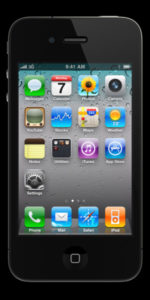Last week I bought my first smart phone – an iPhone 4. I had been holding out for years, using a prehistoric LG Electronics flip phone circa 2005, on a pre-paid Verizon plan of $15 a month, because I don’t make many mobile phone calls. Most of my work is done at my desk in my home office. And even if I am on the road, I prefer to use a landline for phone interviews because the sound quality on most cell phones is crummy.
What I finally realized, however, is that I didn’t need the smart phone for the phone part. I needed it for the “smart” part, the computer capabilities that it provides. When I’m on the road, or even across the street shopping for groceries, I need to be available to my clients. If someone sends me an urgent e-mail, I need to respond right away.
The single most important reason I finally took the plunge is that a smart phone is a good backup system when my power goes out. As I’ve mentioned in previous blog posts, I live on a weak part of the electricity grid and am the victim of frequent power outages of fairly long duration. Short of getting a generator, the next best solution was to upgrade my phone so that I could continue to access my e-mail and the Web even if my lights went out. Since this access was the primary force driving me to upgrade, I wanted the most reliable wireless carrier. When the iPhone finally came out on Verizon Wireless, I decided the time was right.
What I didn’t expect was how useful the iPhone would be in so many different ways. For example, it not only serves as my most reliable connection to e-mail and the Internet (assuming I keep it charged), but it also may become a key component of my computer backup system. By using the cloud and the phone, I can have access to just about any file I need even if my power goes out. By storing my files and notes online at Dropbox, which provides a basic amount of storage for free, I still have access to them even when the power goes out. Granted, I can’t exactly edit and write stories with my thumbs on the iPhone keyboard, but I can at least send a story to an editor if need be.
The phone also gives me a great way to save not only files but also story ideas. I get these ideas all the time, but if I don’t write them down (and I almost never do) I forget them quickly and usually permanently. Now I can use the iPhone’s voice recorder to take note of that great idea and what sparked it.
I also didn’t realize how useful this pocket computer would be in my daily life. Using the Notes app, I keep a running list of things I need to pick up, such as office supplies and groceries. Now as long as I have the phone with me I also have those lists available, so when I happen to stop at Staples or the local grocery store I’m not wracking my brain to try to remember that I needed an HP 901 printer cartridge or a package of Shiitake mushrooms.
My iPhone also serves as my brag book about my son. Rather than pulling a three-year-old school photo out of my wallet, I can show people the latest pictures of him on Facebook, as well as some of his latest performances (he’s an actor and singer) on YouTube.
And he, an iPhone user for years, has turned me on to Pandora, an app that lets you build personalized music channels and also recommends new music that its algorithm says might suit your taste. So now I’m broadening my musical horizons while on the treadmill at the gym.
After resisting mobile phone technology for years, I’m now hooked. And I haven’t even made a phone call.
